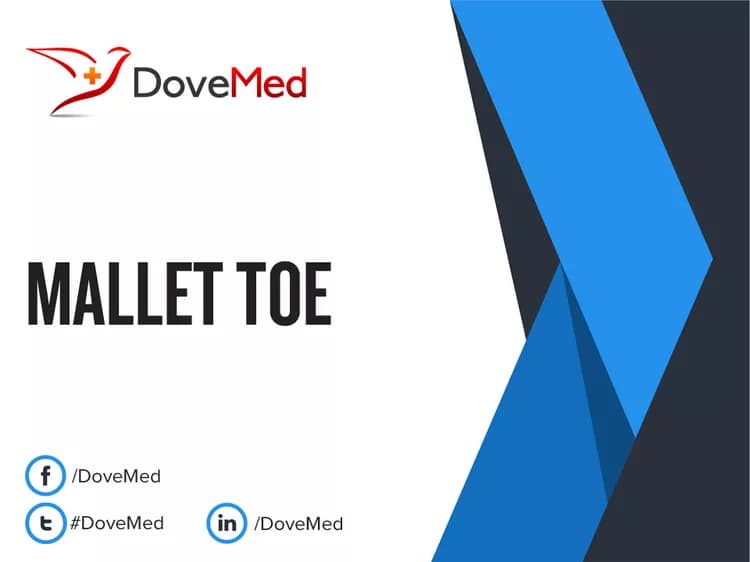What are the other Names for this Condition? (Also known as/Synonyms)
- Mallet Feet
- Mallet Foot
What is Mallet Toe? (Definition/Background Information)
- Mallet Toe is defined as a deformity, where the distal joint of the toe is bent downwards, resulting in a mallet configuration. A mallet is a kind of small hammer
- This condition predominantly occurs in women wearing high-heeled shoes with a narrow toe box
- Even though Mallet Toe usually affects the second toe, it can affect other small toes too. Typically, the big joint is not affected
- Treatment associated with the condition includes both nonsurgical and surgical methods and the prognosis is good with proper treatment
Who gets Mallet Toe? (Age and Sex Distribution)
- Mallet Toe may occur in individuals of all ages, races, ethnic groups, or genders
- Overall, women have the highest rate of occurrence of this condition
What are the Risk Factors for Mallet Toe? (Predisposing Factors)
The common risk factors associated with Mallet Toes include:
- Excessive use of high-heeled footwear by women; women are more likely to develop Mallet Toes, than men
- Injuries to the foot
- Type I diabetes
- Psoriasis (causing psoriasis arthritis)
- Rheumatoid arthritis
- Cerebral palsy, multiple sclerosis
- Charcot-Marie-Tooth disease
- Degenerative disc disorders
- Peripheral arterial diseases, stroke
- Peripheral neuropathy
- Congenital deformities of the foot, presence of flat feet
- Individuals, who have a family history of Mallet Toes may have an increased risk of the condition
It is important to note that having a risk factor does not mean that one will get the condition. A risk factor increases ones chances of getting a condition compared to an individual without the risk factors. Some risk factors are more important than others.
Also, not having a risk factor does not mean that an individual will not get the condition. It is always important to discuss the effect of risk factors with your healthcare provider.
What are the Causes of Mallet Toe? (Etiology)
One of the primary reasons of Mallet Toe is abnormal muscles in the foot, caused by various factors. These include:
- Wearing tight shoes, which puts an abnormal pressure on the toes
- Injury to the toe, resulting from rheumatoid arthritis, or other conditions
- Congenital defects affecting the feet
- Studies have indicated that Mallet Toes has a genetic component
What are the Signs and Symptoms of Mallet Toe?
Signs and symptoms of Mallet Toes include:
- Pain in the toes and foot
- Abnormal gait during walking
- Presence of corns of the foot, due to excessive pressure
- Painful ulcers at the region of increased stress
- Though any toe may be affected, Mallet Toe commonly affects the 2nd toe
How is Mallet Toe Diagnosed?
Diagnostic methods that a physician may use to help diagnose Mallet Toes include:
- Physical examination: A physician can diagnose Mallet Toes by performing a thorough physical examination of the foot. In addition to this, a complete medical history can aid in arriving at a definitive diagnosis
- X-ray of foot: A physician may also order an x-ray, to evaluate the bones and joints of the feet and toes
Many clinical conditions may have similar signs and symptoms. Your healthcare provider may perform additional tests to rule out other clinical conditions to arrive at a definitive diagnosis.
What are the possible Complications of Mallet Toe?
Complications of Mallet Toes could include:
- Constant swelling, persistent pain in the foot
- Deformity of the foot
- Recurrence of a treated (or removed) bone spur
- Stiffness in the foot
How is Mallet Toe Treated?
Both nonsurgical and surgical treatment methods are available for Mallet Toes and these include:
- Application of ice/cold pack to the toe or foot
- Non-steroidal anti-inflammatory oral medications, such as indomethacin and naproxen, may be used to treat Mallet Toes. These medications can help decrease the pain and swelling
- Wearing shoes with soft insoles; the use of insoles to relieve pressure on the foot, until there is a complete healing
- Individuals are likely to need physical therapy exercises. The goal of these exercises is to stretch the toes, back to the normal configuration
Surgical treatment methods include:
- Arthroplasty of the affected region: Arthroplasty is a surgical correction performed by trimming the proximal phalangeal head, which results in straightening of the affected toes. Multiple surgeries may be required to achieve optimal results. If arthroplasty is ineffective, then a more invasive surgical procedure, called arthrodesis, may be necessary
- Arthrodesis of the affected region: Arthrodesis is an invasive surgical procedure that uses metal pins to hold the middle phalanges and proximal bone together. Since, arthrodesis is a more invasive surgical procedure; the recovery period is much longer. During the recovery period, optimal fusion of the proximal bone and the middle phalanges is achieved
How can Mallet Toe be Prevented?
A few preventative methods of Mallet Toes include:
- Wearing the appropriate footwear, such as shoes with adequate toe room, shoes of the correct sizes; avoid high-heeled shoes
- Proper treatment of the following disorders and conditions will help prevent Mallet Toes, in such individuals:
- Type I diabetes
- Psoriasis
- Rheumatoid arthritis
- Cerebral palsy
- Charcot-Marie-Tooth disease
- Peripheral arterial diseases
- Peripheral neuropathy
What is the Prognosis of Mallet Toe? (Outcomes/Resolutions)
- The long-term prognosis of Mallet Toes is usually good, in a majority of the individuals
- When properly treated, a high percentage of individuals regain their full strength and range of motion, in the toe or foot
Additional and Relevant Useful Information for Mallet Toe:
The following DoveMed website link is a useful resource for additional information:
Related Articles
Test Your Knowledge
Asked by users
Related Centers
Related Specialties
Related Physicians
Related Procedures
Related Resources
Join DoveHubs
and connect with fellow professionals


0 Comments
Please log in to post a comment.